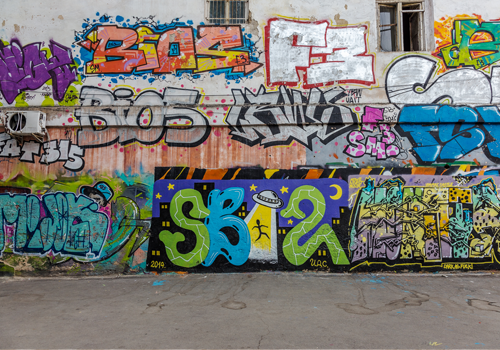Graffiti and street art are inextricably associated. The word 'graffiti' is derived from the Italian word 'graffio', meaning "a scratch." During the Paleolithic age, even the early humans expressed themselves artistically. In essence, the few of the first art known to mankind was graffiti! These etchings have been discovered across the globe, from Australia to Africa to North America to Siberia. Graffiti was first used as a term in 1851 in reference to ancient inscriptions carved on the walls of the ruins of the city of Pompeii. The World Wars brought the phenomenon of "Kilroy was here" – a simple doodle that occurred with variations. Soldiers and sailors scribbled the drawing on equipment and shipments around the world. You can still find the occasional "Kilroy" drawn today. The Berlin Wall was constructed in 1961 to divide Communist East Berlin from West Berlin. While the east remained stark, people adorned the west side with a wild range of graffiti, expressing themselves freely.
The definition of graffiti has expanded and includes all kinds of public art, from simple doodles to elaborate street art. The style of graffiti that most people have seen and know about that makes use of spray cans, came from New York City in the late 1960s, and was born on the subway trains. Taki 183, who lived on 183rd street in Washington Heights, worked as a messenger. He travelled all throughout the city and wrote his name at subway stations and also the insides and outsides of subway cars using markers. He became popular across the city as this mysterious figure. After an interview of him was published by the New York Times, kids in New York began to emulate him, realizing how famous they could get by "tagging" their names on subway cars and as many places as possible.
Graffiti is still evolving and has come a long way from simple bubble lettering spray-painted on a surface to skilled and esoteric lettering like Wildstyle. English street artist Banksy has used spray cans and stencils in his street art while artists like Vhils and BLU have experimented with street art using different kinds of methodology. Some street artists such as Jean-Michel Basquiat and Keith Haring have transformed their artwork into mainstream art gallery fare. Graffiti has given birth to artists who have made stunning murals and incorporated video art too.
What makes graffiti even more fascinating is that it exists in the public for the public. It is often eradicated as it is perceived as vandalism, questioning powerful authorities. However, the artists have achieved commercial success owing to its increasing popularity and have a regular presence in pop culture and the contemporary world of art. We hope this article gave you a new perspective on graffiti and things you didn't know about it before!
